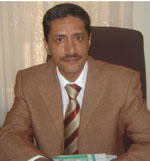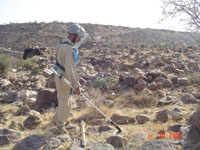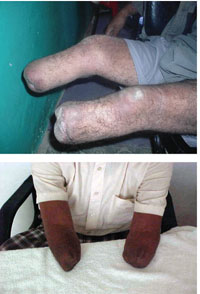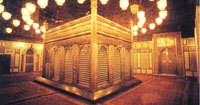
Landmines exist in nearly every governorate, says Al-Azi [Archives:2008/1143/Reportage]
April 3 2008
 |
 |
 |
hamed_thabit@hotmail.com
Every Yemeni governorate except for Al-Mahweet has a problem with leftover landmines from past conflicts. The Yemeni Executive Mine Action Center began in 1999 to clean up all mines from suspected areas. Mansour Mohammed Al-Azi, general director and program manager for the UN Development Program (UNDP) and the chairman of the mine center spoke to the Yemen Times about his organization's plan to make Yemen completely landmine-free by 2014.
Could you give us some background about landmines in Yemen?
Over the past 30 years, landmines were planted in Yemen during four different conflicts. The first was a 1962-1975 conflict between republicans and royalists in the north. Then from 1963 to 1967 [there was] the war of independence in the south. After that, in 1970-1983, the leftist guerrilla war in the central governorates. Finally, in May-July 1994 in the separation war. No mines have been used since 1994.
What were the obstacles in locating the landmines around Yemen?
The worst obstacle was that we did not have any information regarding mines that had been planted between 1962 and 1983. For this reason, Yemen conducted a level one impact survey from 1999 to 2000 to locate the suspected mine fields. The survey was specifically designed to identify the problem in Yemen, because we did not have any maps or information, as almost all of these mines had been planted randomly and by untrained people [the national front]. That is why mines are spread randomly all over Yemen.
However, the situation in 1994 was different. We have some maps, but not with all the information we need. There is always missing [information], like for example, the size of the mines, the number of mines in each field and also if it is mixed with anti-tank or anti-personnel [landmines]. Before we embarked on the level one impact survey in 1999, the number of suspected areas with mines were 1,200.
What were the criteria for selecting these areas?
These places were first and foremost selected by the citizens and not the government. So after the survey, we concluded that there are 594 villages planted with mines, which means that almost 700 villages were free of mines.
Can you tell us the number of landmine victims in Yemen?
I have to assure that the number of the victims has decreased since we started our program in 2000. Before 2000, the number of the dead and injured was 27 per month. However, from the second year of our project in 2000 the number reduced to 1 – 2 people per month, which means 17 to 25 per year dead and injured. The total number of landmine victims in Yemen so far stands at 5,400 victims [dead and injured]; of these, 2,990 were injured.
Most of the victims are women, children and farmers. Children and women are the most vulnerable groups due to the nature of their activities, such as shepherding, playing and collecting wood for fire. We have 827,000 people living next to lands affected by landmines. So far we have reached 670,542 of them and made them aware about the risks and dangers that could happen to them because of mines.
How many areas are free of mines?
From the 594 [communities with landmines], we cleared and marked 338 areas. From the 338 areas, we found 630 mine lands. From the 630 mine lands, 524 are free of mines and 35 are still being worked on. Sixty-one mine fields will be cleared in the future.
The total area affected or suspected to be affected by mines is 923,000,000 square meters, which represent the 594 communities. The mine action program has surveyed and cleared 691,838,911 square meters out of 923,000,000 and the rest is in the process of clearance.
Sometimes an area or village might have more then 4 to 6 minefields. For example in Lahaj, in the mountain it will be more than 30 minefields.
When will Yemen be free of mines?
Yemen will be free of mines in 2014, and will be free of effective mines and anti-personnel mines by March 2009. The most interesting thing is that in 1999, Yemen was on the list of the 24 most affected countries with landmines. However, I can say that Yemen has improved and very soon will be taken off that list. On June 2006, three governorates, Aden, Hajjah, and Hodeidah, were declared free of landmines.
How many accidents happened to your team while working in mine fields?
In general since 2000, 74 were injured and 57 died from our team. In 2007, we had 23 dead and injured from our staff.
What kind of treatment do the mine victims get, including victims from the team?
The mine action center created a unique program in 2001 called the Victim's Assistance Program. The program provides immediate and long-term medical assistance, rehabilitation and support to landmine survivors. Survivors are taken to a hospital and all costs, including medical rehabilitation, transportation and accommodation, are covered by the program.
Each of them has a file and we do not wait for them to come, but we go to them and take them to hospitals at our expense and provide surgery and medical care. After that, each survivor will have a report and [we] provide for their needs, including hearing aids, eye glasses, eye surgery, prosthetic devices and physiotherapy.
The injured from our team [soldiers] will be given monetary compensation and medical treatment. Our soldier victims will be treated as soldiers with honor, who sacrificed their lives for saving the country.
There is also a program called Mine Risk Education. We have three teams and their job is to travel to suspected and affected areas before we go there in order to provide training and briefings on landmines and other explosive devices to reduce casualties and reduce risks among the people in affected areas.
Afterwards, the injured are helped by the committee, by being provided with small projects like dressmaking, handicrafts, mechanics and carpentry. The other highly important work this committee undertakes is the awareness program and every 15 days they travel all over Yemen and go from house to house to ensure the people are aware of the risks of mines. The problem that the villagers face is that many of them did not even know what a mine looked like, but now they have an idea.
How do you work in the mine fields?
Technical survey teams collect information from community leaders and landmine survivors on the location and size of the affected land, the type and depth of mines, and ground conditions. They then mark minefield boundaries, produce an operational map for clearance methods (manual, canine, mechanical or a combination). A clearance unit or mine-dog group will then clear the land inch by inch until all the mines are removed. Cleared lands are then subject to quality assurance, where two officers will inspect a certain portion of the land to ensure it has been cleared in accordance with the national mine action standards. Finally, cleared lands are handed over to the local community for use in a formal ceremony.
In the survey teams, we have 12 teams, and each team has seven people; five surveyors, the medic and the driver. All of them are highly-trained by international standards. Their mission is to identify and find the mines in the suspected areas. It is a very difficult job.
\r\nWho supports and funds the Mine Action Center?
\r\nWith an annual budget of $6.5 million, our center works under the National Mine Action Committee in cooperation with UNDP. The cost of mine operations in Yemen varies annually, with the Yemeni government providing 50 percent of our budget in remuneration for national staff (salaries, field allowances and other benefits, such as health care and social security).\r\n
\r\nWe've received additional contributions via bilateral channels or the UNDP from the governments of Belgium, Canada and CIDA (the Canadian International Development Agency), Germany, Italy, Japan, the Netherlands, Norway, Saudi Arabia, Sweden, Switzerland and the United Kingdom, but even this support sometimes isn't enough.\r\n
\r\nTechnical difficulties also are a major problem because Yemen has vast deserts and sandy areas, which makes our work more difficult.
——
[archive-e:1143-v:18-y:2008-d:2008-04-03-p:report]


